A zoo curator shares his Angolan python secrets.
Angolan pythons (Python anchietae) have long been considered unavailable to both zoo and private collections. The snake has a limited range, often within harsh and inaccessible habitat, and it’s scarce in captivity. However, with ever-improving captive maintenance and breeding husbandry, the availability of these animals has gotten better in recent years, and this handsome, moderately sized snake has found its way into the hearts and private collections of snake-fanciers around the world.
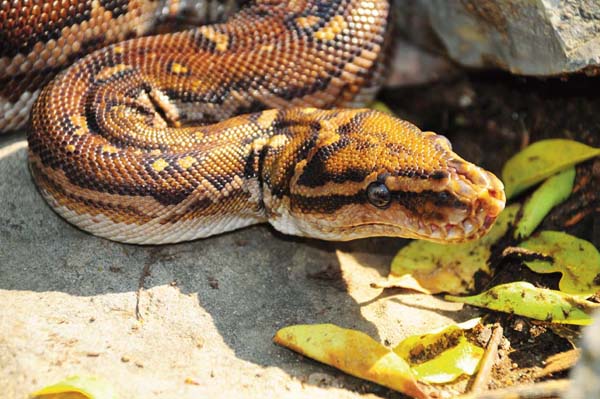
Photo by Phil Colclough
Angolans look good in naturalistic terraria, but anchor all cage furniture..
Angolan Python History
When J.V. Barbosa du Bocage first described this species in 1887, naming it for the famous Portuguese explorer José de Anchieta, there was no indication of the interest it would continue to generate more than 120 years later. Python anchietae is mostly limited to a relatively small range in southwest Africa along the eastern margin of the Namib Desert. Extending from northern Namibia to southern Angola, this area gets little to no precipitation for years at a time. Dependence on microhabitats such as rocky outcroppings and caves provide the only relief from the harsh elements of this environment. Temperatures can range from the low extreme of 32 degrees Fahrenheit up to 122 degrees.
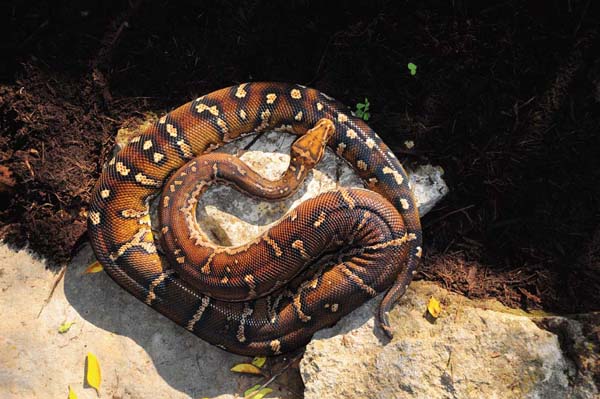
Photo by Phil Colclough
In their harsh natural habitat, these snakes find releif in natural rocky outcroppings and caves.
Little is known about the python’s natural history in the wild due primarily to its isolation within its range, some of which has experienced war and political unrest. From limited field observations made over the years, Angolan pythons seem to occupy rocky, dry habitat with populations concentrating around intermittent water features, whether these be natural or man-made. Gerbils and ground birds are their primary choice of prey, but lizards and even some invertebrates fill a small portion of the diet when the opportunity arises.
Description
Although this species bears a striking resemblance to its much more widespread cousin, the ball python (Python regius), the similarities are only superficial. Dictated by environment, body morphology is drastically different.
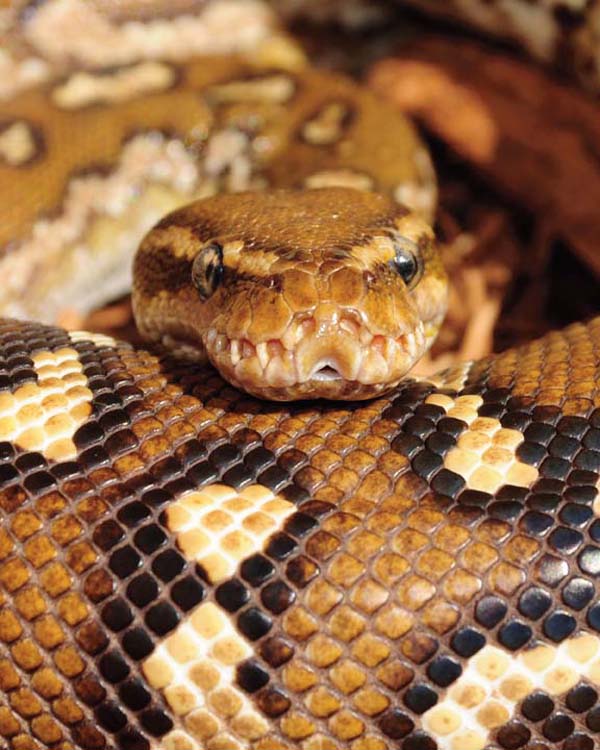
Photo by Phil Colclough
This Angolan python’s labial heat-sensing pits are easy to spot. These pits help wild pythons find meals during their nocturnal hunts.
The Angolan python’s scalation is arranged like beads glued to the surface of its body. Unlike most snakes, they have a very bumpy feel. This scalation is very common in reptiles occupying arid environments, and it acts as an efficient means of collecting and keeping what little moisture they encounter, such as seasonal rains or condensation. Savannah monitors (Varanus exanthematicus), Gila monsters (Heloderma spp.) and speckled cape tortoises (Homopus signatus) are among the other species exhibiting this peglike scalation in order to maximize water uptake and retention.
Proportionally large eyes on the sides of the snake’s relatively small head give the species an almost bug-eyed appearance, and they are another adaptation to the harsh environment. Like many animals from desert biomes, most of their foraging activities must occur at night out of the heat of the day, and large eyes are necessary to take in the needed light for nocturnal foraging.
Another adaptation is the exaggerated pitting adorning the upper and lower labial scales. These pits serve them well during nighttime forays. Evolving over millions of years, heat-sensing pits are one of the hallmarks of boid adaptation that set many of them apart from many other snake families. Labial pits allow the pythons the luxury of stationing themselves along scent trails at night and waiting in ambush for prey rather than expending energy to actively search for their next meal.
Angolan Python Captive Care
Captive care of Angolan pythons is fairly straightforward and predictable. Although the species thrives in stark, clean conditions, it really lends itself to elaborate setups with rocky shelves and attractive arid plantings. Caution must be taken, however, when constructing these sophisticated setups. Anchor all rocks and other cage furniture. Although these snakes are fairly small in relation to many other boids, they are stocky, strong and capable of destroying a terrarium (and possibly injuring the occupant) in one evening.
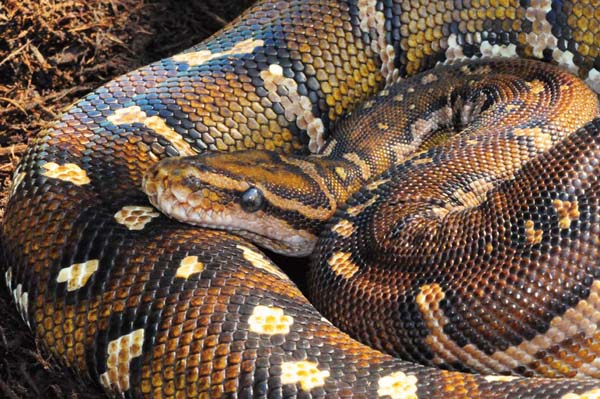
Photo by Phil Colclough
Proportionally large eyes help these snakes forage for food at night.
An absorbent, dry substrate, such as shredded aspen, at least 4 or 5 inches deep is the best and most economical cage bedding. This provides the opportunity to burrow. I have also found that aspen bedding is much easier to spot-clean.
A mature Angolan python can reach lengths of more than 4 feet with a reasonably hefty girth, and this size requires a fairly large enclosure. A terrarium or custom cage should be no smaller than 2 feet long, 2 feet wide and 2 feet tall for a single animal. The Knoxville Zoo provides a slightly taller enclosure, but the extra height isn’t necessary.
Ambient temperatures should remain around 78 to 80 degrees Fahrenheit with a basking spot no higher than 90 degrees on one end of the enclosure. Provide this temperature range year round with no discernable drop at night. The exception is a short cooling period in the fall for breeding purposes.
The secretive nature of this species requires that they have the opportunity to hide. A simple hide box or an elaborate cave can provide that, but it must be large enough for the snake to coil comfortably inside with no part of its body exposed. If space allows, provide two hides, one at the cool end and one at the warm end of the enclosure, to let the snake thermoregulate.
Unlike many python species, Angolan pythons rarely need misting. Dry sheds have never been a problem in the zoo’s collection. If a dry shed does occur, however, an hour-long soak in about 3 inches of room-temperature water in a separate container should help to alleviate the problem.
Angolan Python Food And Nutrition
At the Knoxville Zoo we feed freshly killed mice or frozen-thawed rats depending on the snake’s size. Live prey of any size should never be left unattended in a snake enclosure. Uneaten rodents have been known to attack and kill snakes in just a short period of time.
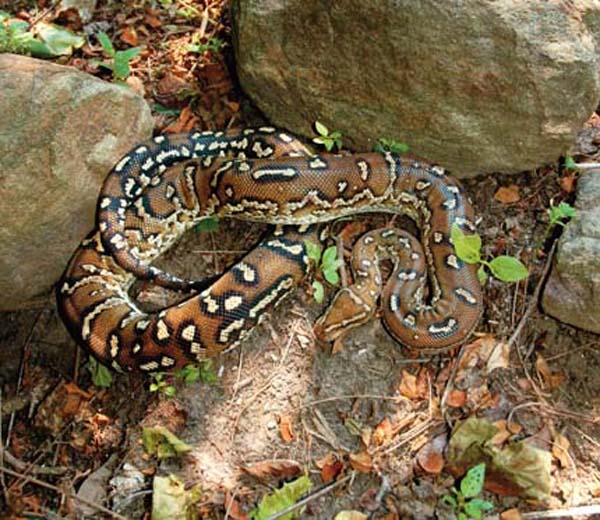
Photo by Phil Colclough
A limited range and inaccessible habitat have contributed to the Angolan python’s limited availability.
Angolan pythons have a tendency to get rather fat if overfed, so feeding juveniles one small weaned mouse per week should suffice. As adults, a couple mice every 10 days is optimal for maintaining a healthy body weight.
These pythons would rarely encounter standing water in their native habitat. They probably get most of their moisture from the prey items they consume. However, at all times provide captive pythons with a water bowl large enough for the snake to completely soak.
Breeding Angolan Pythons
Like most breeding projects, the key to success with Angolan pythons begins with a healthy pair. The Knoxville Zoo has successfully bred this species by housing a pair together year round and also by separating sexes for the whole year except during breeding introductions.
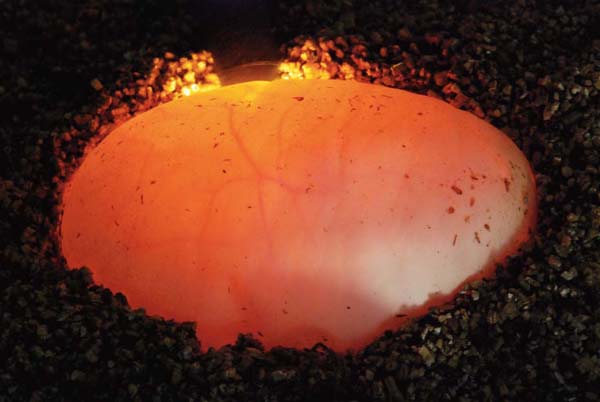
Photo by Phil Colclough
Eggs are incubated at 88 degrees.
A nighttime drop of approximately 10 degrees is achieved gradually over a period of two weeks, so the ambient temperature drops from 78 to 80 degrees down to 68 to 70 degrees. The daytime ambient high of 80 degrees continues during this cooling period. It is initiated on Oct. 1 because this time of year seems to be key for triggering ovulation and subsequent copulation in this species. Probably due to the shorter days and natural temperature drops, the fall season traditionally works well for most captive python species in North America. At the Knoxville Zoo the nighttime temperature drop lasts through the end of November.
Due to the heftiness of most captive individuals, an obvious ovulation is sometimes missed in the female. Breeding is usually observed after dark with longer periods lasting well into the next day. If copulation is successful, it becomes apparent during the subsequent two months. Gravid female Angolan pythons become heavily distended, due primarily to the large egg size, as egg laying draws near.
When females appear gravid, they are separated into individual enclosures with a nestbox containing slightly damp long-fiber sphagnum moss. Nestboxes for zoo boids are appropriately sized terra-cotta flowerpots flipped upside down on their tops. They provide an opportunity for the snake to comfortably coil inside. Size differs depending on the size of the nesting female. The drain hole in the bottom of the pot is enlarged and smoothed, so the gravid snake may pass comfortably through it and not risk injury.
We like using these pots because the clay in the pot retains moisture, maintaining roughly 100 percent humidity inside the nest cavity without directly spraying the substrate. After initially moistening the nest material and inner pot, only the outside of the nesting pot receives additional direct spraying. The clay pores absorb the moisture sprayed on them from the outside and slowly wick that moisture into the nest cavity.
In all three egg-laying events that have taken place at the Knoxville Zoo, a pre-egg-laying shed occurred 20 to 25 days before the actual egg laying. One interesting observation is that this pre-egg-laying shed appears to be much more dramatic in boids than in colubrids. The oily secretion separating old and new skin appears to be much thicker or more concentrated. This is apparent mostly behind the python’s eye spectacle. Instead of the moderately milky appearance in a regular shed cycle, the spectacle appears almost completely white. This has been observed at the zoo during the pre-egg-laying shed of green tree pythons (Morelia viridis), as well.
Angolan Python Egg and Hatchling Care
At the zoo, Angolan python clutch sizes have numbered between seven and 10 large eggs weighing more than 140 grams each. After the female lays in the nestbox, eggs are carefully removed, and they’re separated if adhered together. Egg separation, if done gently and slowly, is a relatively easy task with python eggs.
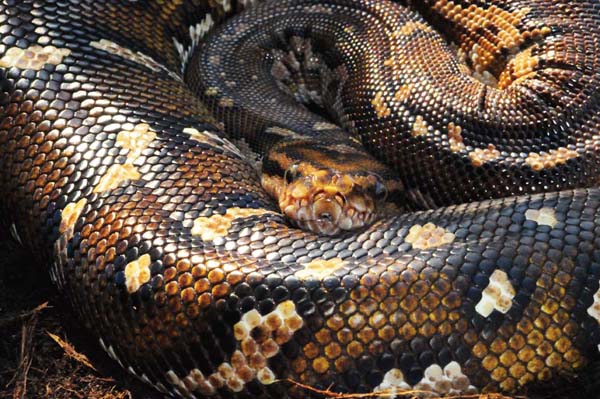
Photo by Phil Colclough
Angolans rarely need misting. Dry sheds do not appear to be a common problem.
Eggs are buried in small-grained vermiculite with the top half visible in the same orientation they were found within the nestbox. This vermiculite is moistened so when it’s squeezed together it adheres in a clump, but water cannot be wrung out of the mixture. If the initial setup of the vermiculite is done correctly, spraying eggs is usually unnecessary throughout the incubation period.
Angolan python egg fertility can be immediately determined by candling eggs in a dark room. Veins running through them are very large compared to most other boid eggs, but this may only be due to the larger egg size.
Eggs are placed in an incubator at a constant 88 degrees. Incubation periods seen at the zoo have been 65 days. On day 65, neonates begin emerging on their own, but the remaining eggs are manually pipped at this time. We slightly pinch a fold on the top of the egg and make a small, shallow, triangular cut with a pair of small, sharp scissors.
Manual egg-pipping is rather controversial, and opinions are divided. We advocate manual egg-pipping with pythons if the incubation period can be accurately determined by past personal experience, or from that of others working with the same species within the same temperature and humidity parameters. We have found few dead, fully formed neonates in python eggs using this technique. In fact, on one occasion green tree python eggs were manually pipped a week too early, and all babies emerged fully formed and pigmented from the slit at the prescribed hatching day. The eggs of many python species are much more resilient than is commonly thought.
Neonate Angolan pythons measure 7 inches long and weigh as much as 70 grams in some cases. These hardy hatchlings are initially set up in sweaterboxes measuring 15 inches long, 101⁄2 inches wide and 6 inches tall with slightly moist paper towels for substrate. After the first shed, the paper towels are removed and replaced with aspen shavings. A small, fairly shallow water dish should be placed in each baby’s enclosure.
Hatchlings have an incredibly strong feeding response, and it’s readily observable after the initial shed takes place about 10 days after the snakes emerge. Feeding begins almost immediately on small pre-killed or thawed weanling mice. For the occasional holdout, live mice may be necessary to elicit a feeding response, but don’t leave rodents alone with the neonates.
Rare Appeal
Angolan pythons may be one of the scarcest pythons in collections today, but it is not due to a lack in appeal. These relatively small, shy ophidians certainly have some of the most attractive qualities available for any captive snake species. Ease of care, a docile disposition and relatively simple captive-breeding parameters truly make this species one of the most desirable captives.
Hopefully greater genetic diversity will be mixed into captive populations in the years to come, and a subsequent increase in captive-breeding rates will make this wonderful species an option for both zoos and private collections alike.
PHIL COLCLOUGH is curator of herpetology at Knoxville Zoological Gardens in Knoxville, Tenn. He has been a full-time employee for more than 14 years. His herpetological interests vary, but snakes are his primary passion.


